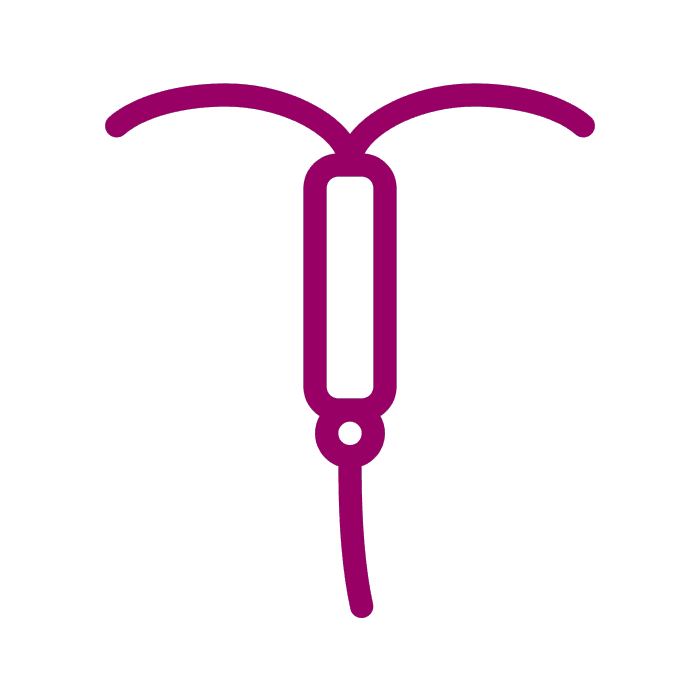
STERILISATION
Permanent Method
Sterilization is the process of completely taking away the body’s ability to reproduce through surgery or minimal invasion.
99 % Effective
Details
Sterilisation is a surgical procedure to prevent pregnancy permanently. Both men and women can be sterilized.
Female sterilisation involves cutting or sealing the fallopian tubes, preventing eggs from travelling down the fallopian tubes, which link the ovaries to the womb. The egg then cannot meet the sperm and cannot be fertilised.
Male sterilisation, or a vasectomy, is when the tubes that carry the sperm from the testes to the penis are cut or sealed. It works by stopping sperm from getting into a man’s semen, the fluid that he ejaculates. When he does ejaculate, the semen has no sperm in it and so cannot fertilise an egg. Both procedures are 99% effective in preventing pregnancy. Once you are sterilised, it is very difficult to reverse it, so it is best to consider all your options before making your decision.
How to
Sterilisation is performed by a trained healthcare professional. Depending on the method used, you may either have a general anaesthetic, where you’re asleep during surgery, or a local anaesthetic, where you are awake but will not feel any pain. You will need to use contraception for 3 months after the procedure, and then you will not need to think about contraception again.
Pros
It is a highly effective method of contraception
It is permanent so you will not need to think about contraception again
It does not affect your hormone levels or sex drive
It does not interrupt sex
Cons
It cannot be reversed
You will need to use contraception for 3 months after the procedure
It does not protect you from sexually transmitted diseases
Some people experience pain and discomfort after the procedure
There is a small risk of complications, including infections
Side Effects
There are no known side effects
Frequently Asked Questions
-
Sterilisation is the process of completely taking away the body’s ability to reproduce through surgery or minimal invasion.
-
No. Most research finds no major changes in bleeding patterns after female sterilisation. If a woman was using a hormonal method or IUD before sterilisation, her bleeding pattern will return to the way it was before she used these methods. For example, women switching from combined oral contraceptives to female sterilisation may notice heavier bleeding as their monthly bleeding returns to usual patterns. Note, however, that a woman’s monthly bleeding usually becomes less regular as she approaches menopause.
-
No. After sterilisation, a woman will look and feel the same as before. She can have sex the same as before. She may find that she enjoys sex more because she does not have to worry about getting pregnant.
-
No. After sterilisation, a woman will look and feel the same as before. She can have sex the same as before. She may find that she enjoys sex more because she does not have to worry about getting pregnant.
-
Tubal ligation is very effective at preventing pregnancy and is intended to be permanent. It is not 100% effective, however. Women who have been sterilized have a slight risk of becoming pregnant: About 5 of every 1,000 women become pregnant within a year after the procedure. The small risk of pregnancy remains beyond the first year and until the woman reaches menopause.
-
Sterilisation is intended to be permanent. People who may want more children should choose a different contraceptive method. Surgery to reverse sterilisation is possible for only some women—those who have enough fallopian tubes left. Even among these women, reversal often does not lead to pregnancy. The procedure is difficult and expensive, and healthcare providers who can perform such surgery are hard to find. When pregnancy does occur after reversal, the risk that the pregnancy will be ectopic is greater than usual. Thus, sterilisation should be considered irreversible.














CONTRACEPTIVE METHODS
CONTRACEPTIVE METHODS
-

CONTRACEPTIVE IMPLANT
1 or 2 small hormone-releasing silicone rods placed under the skin by a healthcare provider.
-

CONTRACEPTIVE INJECTION
The contraceptive injection is a shot of hormones that lasts for 1 up to 3 months.
-

CONTRACEPTIVE PATCH
A patch that sticks to the skin and releases hormones that are highly effective at stopping pregnancy.
-

CONTRACEPTIVE RING
A flexible plastic ring that is placed in the vagina by the woman and constantly releases hormones.
-

DIAPHRAGM
A diaphragm is a small dome that blocks the entrance to the cervix to stop sperm from entering the womb.
-

EMERGENCY CONTRACEPTIVES
Emergency contraceptives are hormone-based pills that are used in the event of accidental unprotected sex.
-

FEMALE CONDOM
A female condom is a sheath that is placed inside a woman’s vagina before sexual intercourse.
-

FERTILITY AWARENESS
Fertility awareness is the method of only having sex on the non-fertile days of your menstrual cycle.
-

INTRAUTERINE DEVICE
An IUD is a small, flexible, often T-shaped device wrapped in copper that is placed inside your womb by your healthcare provider.
-

INTRAUTERINE SYSTEM-IUS
An IUS is a small, flexible, T-shaped system that releases low levels of hormones and is placed inside the womb by your healthcare provider.
-

MALE CONDOM
A condom is a thin film sheath that is placed over a man’s erect penis before having sex.
-

PULL-OUT METHOD
Pulling out (also called Withdrawal Method) requires no additional hormones or devices, just impeccable timing and a lot of luck.
-

SPERMICIDES
Spermicides affect the way sperm travels in the womb making it hard for them to move freely and fertilize an egg.
-

SPONGE
A sponge blocks the entrance to the cervix and releases spermicide, both together stopping sperm from entering the womb and fertilizing an egg.
-

THE PILL
The pill is a small tablet containing hormones that must be swallowed every day, at the same time.



